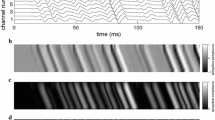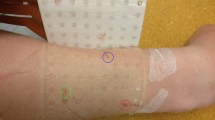Abstract
Purpose
The depth information of muscle motor units is important in clinical applications. The purpose of this paper is to investigate relationship between motor unit action potentials from surface electromyography and motor unit (MU) depth.
Methods
Firstly, the skin structure was depicted, and the action potential was considered as a constant current source, which was generated by a tripole model. Secondly, the potential generated by the tripole on the surface was given. Finally, the relationships between MU depth and MU action potential (MUAP) parameters on the skin were studied.
Results
The regression analysis showed a low relative error for the simulated signals. When the position of the detected electrodes was 18 mm, the linear regression analysis yielded 2.47% in the case of arc, and 2.48% in the case of side. The relationships between the peak to peak amplitude of MUAP and the lengths (arc and side) were tested by the nonlinear regression analysis. The sum of the squared errors was less than 0.0202, and the coefficient of determination was more than 0.9939.
Conclusions
These results show that it is possible to estimate MU depth by action potentials on surface electrodes.
Similar content being viewed by others
References
Yu S, Jeong E, Hong K, Lee S. Classification of nine directions using the maximum likelihood estimation based on electromyogram of both forearms. Biomed Eng Lett. 2012; 2(2):129–37.
Venugopal G, Ramakrishnan S. Analysis of progressive changes associated with muscle fatigue in dynamic contraction of biceps brachii muscle using surface EMG signals and bispectrum features. Biomed Eng Lett. 2014; 4(3):269–76.
Peng Y, He J, Khavari R, Boone T, Zhang Y. PD24-03 identification of innervation zones of the pelvic floor muscle from noninvasive high-density intra-vaginal/rectal surface EMG recordings. J Urology. 2015; 193(4):e487.
Gracies JM. Pathophysiology of spastic paresis. I:Paresis and soft tissue changes. Muscle Nerve. 2005; 31(5):535–51.
Jahn R. A neuronal receptor for botulinum toxin. Science. 2006; 312(5773):540–1.
Lapatki BG, Van Dijk JP, van de Warrenburg BPC, Zwarts MJ. Botulinum toxin has an increased effect when targeted toward the muscle’s endplate zone: a high-density surface EMG guided study. Clin Neurophysiol. 2011; 122(8):1611–6.
Liu Y, Ning Y, Li S, Zhou P, Rymer WZ, Zhang Y. Threedimensional innervation zone imaging from multi-channel surface EMG recordings. Int J Neural Syst. 2015; doi:10.1142/S0129065715500240.
van den Doel K, Ascher UM, Pai DK. Source localization in electromyography using the inverse potential problem. Inverse Probl. 2011; doi:10.1088/0266-5611/27/2/025008.
Wood SM, Jarratt JA, Barker AT, Brown BH. Surface electromyography using electrode arrays: a study of motor neuron disease. Muscle Nerve. 2011; 24(2):223–30.
Liu Y, Ning Y, He J, Li S, Zhou P, Zhang Y. Internal muscle activity imaging from multi-channel surface EMG recordings: a validation study. Conf Proc IEEE Eng Med Biol Soc. 2014; 3559–61.
Zwarts MJ, Stegeman DF. Multichannel surface EMG: basic aspects and clinical utility. Muscle Nerve. 2003; 28(1):1–17.
Roeleveld K, Stegeman DF, Falck B, Stålberg EV. Motor unit size estimation: confrontation of surface EMG with macro EMG. Electroen Clin Neuro. 1997; 105(3):181–8.
Roeleveld K, Blok JH, Stegeman DF, van Oosterom A. Volume conduction models for surface EMG; confrontation with measurements. J Electromyogr Kines. 1997; 7(4):221–32.
Sheean GL. Quantification of motor unit action potential energy. Clin Neurophysiol. 2012; 123(3):621–5.
Rosenfalck P. Intra- and extracellular potential fields of active nerve and muscle fibres. A physico-mathematical analysis of different models. Acta Physiol Scand. 1969; 321:1–168.
Andreassen S, Rosenfalk A. Relationship of intracellular and extracellular action potentials of skeletal muscle fibers. CRC Crit Rev Bioeng. 1981; 6(4):267–306.
Merletti R, Lo Conte L, Avignone E, Guglielminotti P. Modeling of surface myoelectric signals—Part I: Model Implementation. IEEE T Bio-Med Eng. 1999; 46(7):810–20
McGill KC, Huynh A. A model of the surface-recorded motorunit action potential. Conf Proc IEEE Eng Med Biol Soc. 1988; 1697–9.
van Veen BK, Wolters H, Wallinga W, Rutten WL, Boom HB. The bioelectrical source in computing single muscle fiber action potentials. Biophys J. 1993; 64(5):1492–8.
Monster AW, Chan H. Surface electromyogram potentials of motor units: relationship between potential size and unit location in a large human skeletal muscle. Exp Neurol. 1980; 67(2):280–97.
Zhao Y, Li D. A simulation study on the relation between muscle motor unit numbers and the non- Gaussianity/nonlinearity levels of surface electromyography. Sci China Life Sci. 2012; 55(11):958–67.
Gabriel DA, Kamen G. Experimental and modeling investigation of spectral compression of biceps brachii SEMG activity with increasing force levels. J Electromyogr Kines. 2009; 19(3):437–48.
Ning Y, Zhu X, Zhu S, Zhang Y. Surface EMG decomposition based on k-means clustering and convolution kernel compensation. IEEE J Biomed Health Inform. 2015; 19(2):471–7.
Yavuz U, Negro F, Sebik O, Holobar A, Frömmel C, Türker KS, Farina D. Estimating reflex responses in large populations of motor units by decomposition of the high-density surface electromyogram. J Physiol. 2015; 593(19):4305–18.
Dai C, Li Y, Christie A, Bonato P, Mcgill KC, Clancy EA. Cross-comparison of three electromyogram decomposition algorithms assessed with experimental and simulated data. IEEE T Neur Sys Reh. 2015; 23(1):32–40.
Merletti R, Parker PA. Electromyography: physiology, engineering, and non-invasive applications. John Wiley & Sons; 2004.
Farina D, Cescon C, Merletti R. Influence of anatomical, physical, and detection-system parameters on surface EMG. Biol Cybern. 2002; 86(6):445–56.
Mesin L. Real time estimation of generation, extinction and flow of muscle fibre action potentials in high density surface EMG. Comput Biol Med. 2015; 57:8–19.
Author information
Authors and Affiliations
Corresponding author
Rights and permissions
About this article
Cite this article
He, J., Yi, X. & Luo, Z. A simulation study on the depth information of motor units. Biomed. Eng. Lett. 6, 80–86 (2016). https://doi.org/10.1007/s13534-016-0219-1
Received:
Revised:
Accepted:
Published:
Issue Date:
DOI: https://doi.org/10.1007/s13534-016-0219-1




